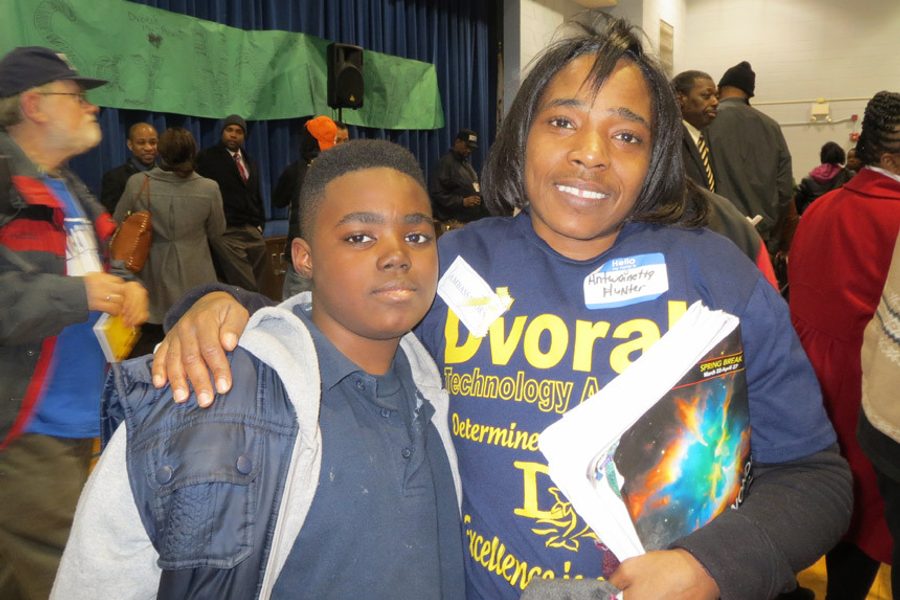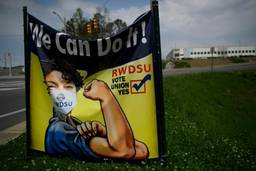Community Members, Including Former Chicago Bull, Unite To Save School From ‘Turnaround’
Kari Lydersen

At 2:50 pm on March 21, as Carrene Beverly-Bass remembers it precisely, her world changed.
That’s when she was told by administrators that Dvorak Technology Academy on Chicago’s West Side, where she has taught for 21 years, was targeted to become a “turnaround school.” This would mean all of Dvorak’s teachers and staff would lose their jobs next fall, when the elementary school would be taken over by a private nonprofit organization: the Academy for Urban School Leadership (AUSL), which already runs 29 Chicago public schools attended by 17,000 students.
Along with North Lawndale’s Dvorak, the Chicago Board of Education is planning to designate two other elementary schools as “turnarounds”: McNair Elementary on the West Side and Gresham Elementary on the South Side are also on the chopping block. In some cases, some employees are retained during turnarounds, but the district has already announced that the plan this time is to remove all staff from the three elementary schools.
“They ambushed us,” Bass says, tears trickling down her face. “It was the most dehumanizing experience I’ve ever had in my life.”
All three schools hosted hearings on April 2 in front of Chicago Public Schools (CPS) and AUSL officials, who were tasked with reporting back to the school board. After another hearing next week at the school board’s downtown central office, the board will vote on the turnaround proposals on April 23.
On Wednesday night, several hundred distraught and furious parents, students, elected officials and teachers — including Bass — gathered in Dvorak’s auditorium to give their testimony unanimously opposing the proposal.
“All I ever wanted to do was teach,” Bass, who currently teaches fourth grade at Dvorak, tells In These Times after making her impassioned remarks to the crowd. “To treat us that way when we just want to teach, it’s so, so disrespectful.”
AUSL and CPS officials started the meeting at Dvorak with a brief introduction about the turnaround process and AUSL. There was a recitation of statistics showing Dvorak’s poor performance on the Illinois Standard Achievement Test (ISAT), where students scored far below state and district averages. Ninety-eight percent of Dvorak students are Black, and nearly all qualify for reduced-price lunch — an indication of poverty.
Pamela Creed, principal of AUSL’s Fuller School of Excellence on the South Side, explained during the introduction that the organization develops a “positive culture” in its schools and sets “rigorous goals” for students. “We do celebrate student achievement,” she said. For example, she continued, “We have college readiness celebrations for students who met their college readiness targets — they have pizza with their principal.”
AUSL’s presentation appeared to be cut short by boos and heckling. Then, one after another, locals took the floor to lambast the turnaround plan. They described the tight sense of community that exists at Dvorak, where multiple generations of North Lawndale families have sent their kids. Several adult speakers pointed out their former grade-school teachers and principal in the crowd. They described the way Dvorak students — many of whom are homeless, have special needs or face other challenges — have family-like bonds with teachers, security guards, lunch ladies and other staff who’ve been there for years.
Various speakers did acknowledge Dvorak’s poor test scores. But, they said, the school has been improving. Many people professed faith and hope in Principal Cheryl White, who has only been in her position for a little more than a year.
And while many pointed out that AUSL schools often don’t perform better than Chicago neighborhood schools on standardized tests, they also reminded officials that scores don’t tell the whole story about a school. “We need to start telling our students they are more than just a test score,” said Toni Minter, a teacher at another CPS school. “This school is worth saving; these jobs are worth saving.”
Numerous speakers charged that the Dvorak turnaround plan is part of a larger agenda: to displace poor Black families from gentrifying neighborhoods. Residents often feel the same way about privately run charter schools replacing longstanding public schools in their areas: They think it is a way to uproot the existing community and open a school that is more attractive to higher-income residents. (Turnaround schools are not charter schools, but critics frequently view them in the same vein.)
“This is a land grab,” said Valerie Leonard, a member of the Lawndale Alliance, who referred to the plan as the “AUSL hostile takeover.” “This is about real estate.”
Locals noted their community’s proximity to downtown and said that people have already been forced out by rising property values. Several speakers, including Minter, said they or people they know have been priced out of the neighborhood but continue sending their kids to Dvorak because they love the school.
“This is bigger than us, they want this land,” Bass tells In These Times. “It’s about the fact that you can see downtown from here. It’s about the red X’s on the buildings” that the city uses to denote homes slated for demolition. “It’s like we’re the victims of something we didn’t do.”
Marquiette Criswell had two kids graduate from Dvorak and has family roots in North Lawndale going back more than 60 years. She, too, sees the turnaround proposal as a struggle over the future of the neighborhood. “They are trying to take our homes, they are trying to take our schools, they are trying to take our jobs,” she testified. “All in the name of gentrification.”
Though students currently enrolled would continue to attend after the “turnaround,” residents expressed worry that problem students might be pressured to leave or that new students with difficult circumstances would have trouble gaining admission.
Donielle Lawson, whom many refer to as “the Jail Teacher” from her stint educating inmates in the Cook County Jail, said in her testimony that she worked in an AUSL school—Dodge Renaissance Academy on the West Side — for about six months. She quit, taking an $18,000 pay cut, because she said officials were rejecting students with poor discipline or attendance records.
“My concern is that our students who have challenges and issues will be turned away — only to end up on the streets,” added Ronald Haywood, formerly a member of the Dvorak Local School Council and a volunteer and basketball coach at the school. “We have a phenomenal principal in Ms. Wright. We have phenomenal parents, we have phenomenal teachers … What we ask for now are resources and support. I ask once again we have resources so our students can remain in a school that is supportive and familiar to them. They say it takes a village to raise a child — Dvorak is that village.”
Though the concept of turnaround schools in the city began more than a decade ago under Chicago’s sweeping school reform plan, critics see its continuation as part of the larger efforts of Mayor Rahm Emanuel and his appointed school board to privatize many aspects of public education and reduce the power of the Chicago Teachers Union. Emanuel’s first two years in office included the seven-day historic strike by the union and the largest round of school closings in U.S. history. Shortly after taking office, Emanuel also announced he wanted to double the number of schools run by AUSL. He chose a former AUSL executive, Tim Cawley, to serve as Chief Administrative Officer for Chicago Public Schools.
“What this is really all about, to be clear — turnarounds are another version of school closings,” testified Pauline Lipman, a professor at the University of Illinois at Chicago, to loud cheers. “The school history, culture and staff, the school community are wiped out.”
She noted that the schools AUSL has taken over are disproportionately in African-American neighborhoods, and that African-American teachers comprised a disproportionate number of those laid off.
Local 24th ward alderman Michael Chandler, State Representative Arthur Turner and Raymond Gye, director of constituent services for U.S. Congressman Danny K. Davis, also spoke out in opposition to the turnaround plan.
Turner said he was only told about the turnaround plan the day before it was announced. “I felt very disrespected by that,” he said to the audience. “The relationship between the community and the teachers is very important. Trying to rebuild the community, 16th street, the West Side of Chicago, we need… the teachers sitting here. … We can do great things here at Dvorak. I’m here in support of the family members and union members today.”
When Mickey Johnson stepped up to testify, the microphone was several feet too low for him. The former Chicago Bulls player, on the team from 1974 to 1979, is now a community activist in North Lawndale, where he grew up. He helps out with the Dvorak basketball program. “Don’t believe the hype,” he told the crowd, charging that the turnaround is really a way to break the teachers union.
“When you take away what a child knows, that’s traumatic,” Johnson tells In These Times after the hearing’s conclusion. “I’m all for change for the better. But this school has been building. We need to keep building on what they already have instead of starting over.”
Kari Lydersen is a Chicago-based journalist, author and assistant professor at Northwestern University, where she leads the investigative specialization at the Medill School of Journalism, Media, Integrated Marketing Communications. Her books include Mayor 1%: Rahm Emanuel and the Rise of Chicago’s 99%.








